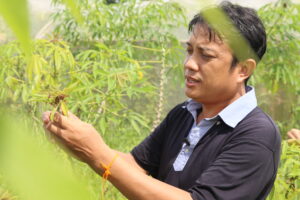
The Invisible Side of Science: Protecting Crops through Nanotechnology
- From
-
Published on
24.01.24
- Impact Area

Uncovering the Root Cause of Witches’ Broom Disease in Cassava
In Southeast Asia, most smallholder farmers rely on cassava: its starch-rich roots form the basis of an industry that supports millions of producers. In the past decade, however, Cassava Witches’ Broom disease has stunted plants, reducing harvests to levels that barely permit affected farmers to eke out a living.
In a recent breakthrough, researchers compared DNA from healthy and diseased plant samples to reveal the underlying culprit behind the disease: the fungus genus Ceratobasidium. With these findings, published in Scientific Reports, plant pathologists in Laos, Cambodia, Vietnam and Thailand are better able to track and stop the spread of Witches’ Broom disease.

Related news
-

Can CRISPR make the cut? How the ‘genetic scissors’ reframe gene editing for food security
The Alliance of Bioversity International and the International Center for Tropical Agriculture (CIAT)02.12.25-
Nutrition, health & food security
This ‘switching off’ (or ‘on’) of genetic pathways has occurred forever as part of natural…
Read more -
-

New Genomic Discovery from ICRISAT Could Save Farmers Millions by Preventing Groundnut Sprouting Before Harvest
International Crops Research Institute for the Semi-Arid Tropics (ICRISAT)02.12.25-
Food security
-
Poverty reduction, livelihoods & jobs
Breakthrough study identifies varieties and key genes to halt sprouting before harvest in groundnut …
Read more -
-

Building resilience: A new era for community seed banks in western Uganda
The Alliance of Bioversity International and the International Center for Tropical Agriculture (CIAT)28.11.25-
Nutrition, health & food security
In western Uganda, community seed banks are key for maintaining agricultural diversity and climate r…
Read more -
